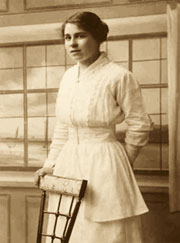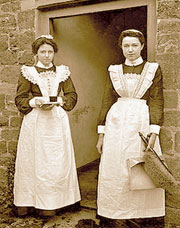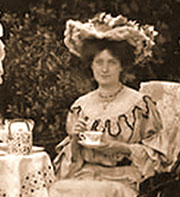Colors come and go, but here are some tried and true direction on which colors to use in your luxury website.
Four Simple Items Pertaining to Good Service
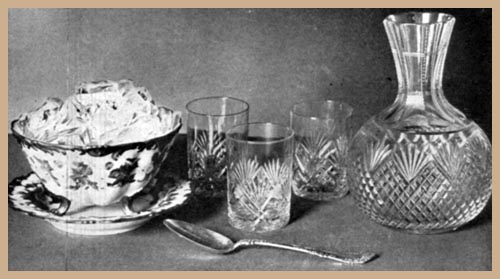 Above: Carafe, Ice Bowl, etc.
Above: Carafe, Ice Bowl, etc.
ICE AND DRINKING WATER
As freezing does not kill harmful germs that may be present in ice, many people object to the use of ice in drinking water and prefer chilled water. Bottled waters, also boiled or distilled water stored in tightly corked bottles, are easily chilled when placed in contact with ice, To avoid waste of ice, boiled water should stand until cool before storing in a refrigerator. When ice is used, it should be broken in small pieces no larger than a hickory nut. A perforated bowl set in a deep plate holds the ice while the dinner is in progress. This is set upon the sideboard. In serving the meal after the English fashion carafes of water are provided for each two or three people at table. These stand between the covers, near the plate line. With one maid let the glasses be filled before the family or guests are seated, then, as they need replenishing, the maid will bring the ice bowl and plate with a spoon on a tray (if water has dripped through into the plate, empty this into a dish kept on the sideboard for the purpose), and put ice into the glasses without removing them from the table. Then one wishing water helps himself from the carafe. Small tumbler plates are provided, the imported ones are often very quaint, which keep the moisture on the outside of the glass from the tablecloth. With many attendants and Russian service the tumblers are not filled until after the guests are seated. Then the oysters are set in place by one attendant, another follows with the sandwiches, pepper, etc., on a tray, and a third follows with the ice bowl and carafe of water, while the fourth pours sauterne.
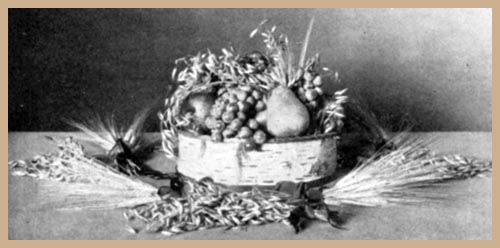 Above: Fruit wth Grain
Above: Fruit wth Grain
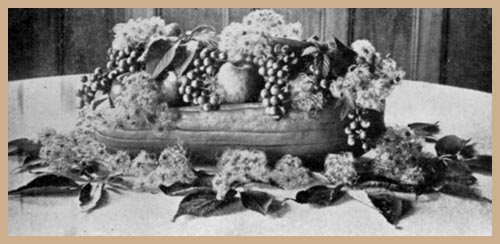 Above: Centerpiece for Long Table. Long Pumpkin Basket with Fruit, Dried Clematis and Pressed Raspberry Leaves
Above: Centerpiece for Long Table. Long Pumpkin Basket with Fruit, Dried Clematis and Pressed Raspberry Leaves
TABLE DECORATION
A waitress who is fond of flowers will certainly enjoy arranging them for the table or house and be glad when this duty is relegated to her. A table laid and served after the English fashion admits of little space for floral decoration. Indeed, unless the table be at least five feet in diameter or breadth, space is not possible for more than a single branch of blossoms, or perhaps two or three stalks, as of iris, in a tall slender vase. A small pot of ferns in a low fern dish cannot be used conveniently on a table less than five feet in diameter.
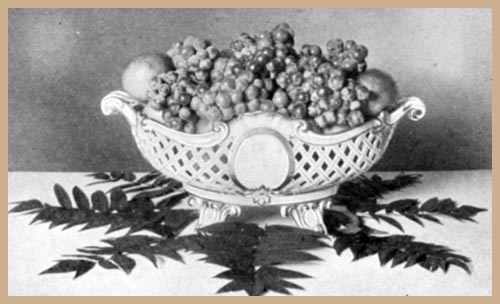 Above: Fruit Centerpiece with Mat of Sumac Leaves.
Above: Fruit Centerpiece with Mat of Sumac Leaves.
When the meals are served Russian fashion, the table top may be divided between "the covers" and the floral decorations; thus, after sixteen or seventeen inches are reserved for "the covers," the whole centre, large or small, may be used for decorative purposes. The simplest device for a round table consists of ferns radiating from a bowl in which are massed a profusion of some one or two blossoms. The flowers may be wired and pushed down into moist sand, or, with a greater abundance, they may stand in water. Stems of grain in variety, as wheat, oats, etc., combine well with autumn fruits for autumn dinners. Indian corn in varied colors, hop vines, clematis after seeding, blackberry and sumac leaves, after turning in the fall, scarlet dogwood berries, and branches of chestnut burrs are all available in late summer or early fall, in country places; but these are too heavy to use in profusion except on a gala occasion. Ground pine, holly, mistletoe, partridge-berry vines, and poinsettias find place in decorating a table at the Christmas holidays, while apple and other fruit blossoms, tulips, and primroses in early spring, are succeeded by sweet peas and roses in June, and poppies with grasses or grain in July. Let each flower used look as if growing; select the utensil which is to hold it, or the method in which it is to be used, with this idea in view. For daily use a few flowers carefully arranged are preferable to a mass of blooms no matter how tastefully handled.
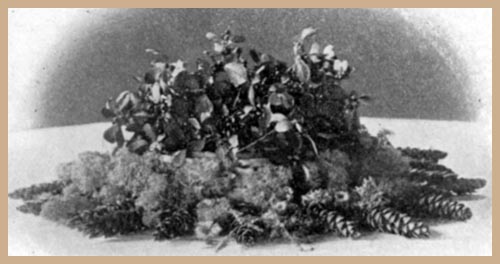 Above: Centerpiece for Early Autumn Luncheon. Pine Cones, etc.
Above: Centerpiece for Early Autumn Luncheon. Pine Cones, etc.
CARE OF CUT FLOWERS
Flowers may be kept for some special occasion in a refrigerator, but they do not retain their beauty iong after such treatment. The water in which flowers are kept should be renewed twice a day, or at least once each day. Cutting off an inch from the stems is probably of advantage.
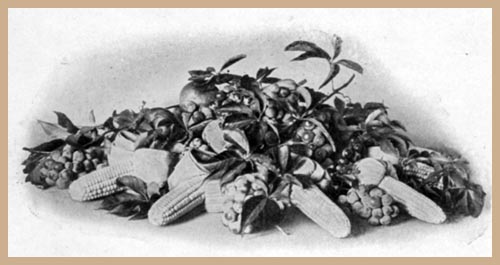 Above: Grapes, Apples and Indian Corn, with Autumn Leaves
Above: Grapes, Apples and Indian Corn, with Autumn Leaves
ATTENDANCE AT STREET DOOR
The well-trained waitress is prompt to answer calls at the door. In the early morning a fresh apron may occasionally be needed, in order that she may be immaculate, but this should be in readiness beforehand, that it may be quickly donned and no one kept waiting. A neatly polished tray will need no u looking up." It will stand in its proper place ready for her hand as she passes by the table on her way to the door.
In opening the door to admit a guest the waitress should neither remain hidden behind it, nor advance so far as to obstruct the entrance.If the caller wishes only to leave a card or a message she should stand well forward and extend her tray to receive it.
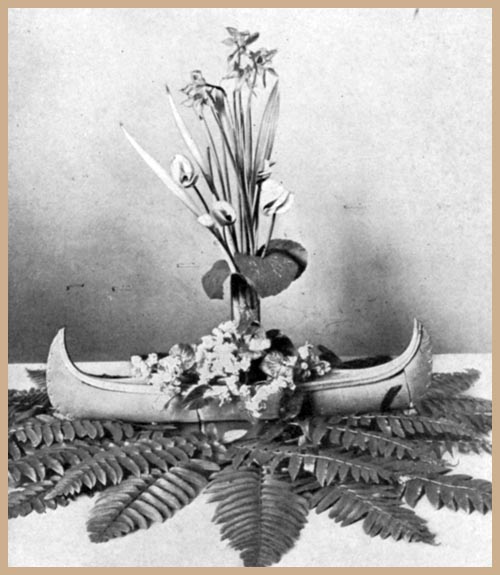 Above: Centerpiece for Spring Luncheon
Above: Centerpiece for Spring Luncheon
The waitress will dispose of a lady's umbrella, of her rubbers and raincoat if she has worn them; she will likewise take care of the overcoat of a gentleman caller, and will offer to take his hat and cane, if he is an intimate friend of the family.Otherwise he will carry these with him into the reception room.But when opening the door for several guests, as in the case of a dinner party, there will not be time for individual attentions, and all the waitress can do is to direct the ladies to the room where they may leave their wraps.The gentlemen usually hang theirs on racks provided in the hall.
A correctly trained waitress knows that a caller is never left standing in the hall, but is always shown into the reception room while the card, or the name, is taken to the hostess.A messenger boy, a tradesman, etc., is given a seat in the hall while they wait to see the one with whom they have business.
Another of the small points of fine service is that door should not be closed after a departing guest until he has descended the steps, if there are steps; or reached his carriage, if one is waiting; or has gone a few steps towards his next destination.
